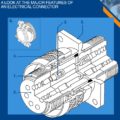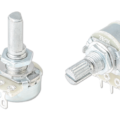According to Expert Market Research, the global transparent display market was valued at around USD 1.25 billion in 2021 and is expected to reach over USD 11.17 billion by 2027. Transparent displays have a futuristic appeal, but they suffer from privacy limitations as content is visible from both sides. However, advancements have enabled single-sided emission from transparent OLED (TOLED) displays, allowing these displays to be made visible only from one side. Here, Dr. Hossein Ardekani, Research Scientist at TOLED specialist Nextgen Nano, explains how this technology can be used.
As a subgroup of OLED technology, TOLED uses self-illuminating LEDs to display an image instead of a backlight. It is possible to use an OLED panel in more interactive display applications where users must be able to see through the other side of the screen by making it transparent.
Conventional TOLED displays have exclusively transparent components, consisting of a substrate, and a multilayer of organic material sandwiched between a cathode and an anode. Any graphics or text shown can be viewed from both sides when they are turned on since they enable light to pass in both directions. For some applications, like smart glasses, the ability to see information presented on both sides can raise significant security concerns.
Single-sided emission TOLEDs are a type of display technology that offer a unique feature: content can be viewed from only one side, while the other side remains transparent, similar to a two-way mirror. This can be used as a privacy feature that restricts the visibility of the display to a specific direction. To achieve this, the emitted light is manipulated by suppressing it from the top electrode and maximising it from the bottom electrode.
How can this technology be used?
In the context of commercial building windows, single-sided emission TOLEDs can be seamlessly integrated into the glass surfaces, transforming them into dynamic information hubs. These displays allow businesses to showcase their products, services, or promotional content to passers-by. The transparency feature ensures that those inside the building can still see outside.
Similarly, the application of this technology in public transport vehicles holds tremendous potential. Installing these displays on the windows of buses, trains, or trams can transform them into moving advertising platforms. Advertisements, relevant information, or engaging content can be presented to pedestrians outside, ensuring that the intended audience receives the message while passengers inside have an unobstructed view.
In the realm of video conferencing, one prevalent issue is the challenge of maintaining eye contact. Unlike in face-to-face conversations where direct eye contact is natural and instinctive, video calls often present a disconnect between participants’ gazes due to the positioning of cameras and displays. Having a transparent screen with a one-sided emission allows the camera to be placed at eye-level behind the display, creating a more authentic and engaging interaction that closely resembles face-to-face conversations.
Single-sided emission TOLED technology can also enhance Heads-Up Displays (HUDs) in road vehicles and aviation cockpits, allowing drivers and pilots to receive vital information while maintaining transparency for an unobstructed view ahead.
HUDs in road vehicles and aviation cockpits present information on the same window through which user sees, like a projector. This works by implementing an additional image forming unit which sends the light to the screen, such as a car’s windshield, which acts like a partially reflecting mirror directing the light to the viewer’s eyes. Because the image formation relies on the light reflecting at an angle onto the windshield, vehicles with vertical windows like buses, vans and construction machinery don’t benefit from currently available HUDs.
Integrating single-sided emission TOLEDs into HUD systems eliminates the need for the image forming unit by making the windshield or helmet visor emit the light by itself, saving space and weight. This provides a significant benefit for head mounted displays (HMDs) where the weight of the AR/VR headsets is a determining factor.
NextGen Nano has achieved results at a scale suitable for commercial development for its TOLED device and is currently welcoming commercial partners. The research into TOLED technology is conducted by the company’s Nanoled division, a team tasked with increasing efficiencies and scaleup for commercial development of its display technologies.
Find out more about Nextgen Nano’s technologies on its website. 








